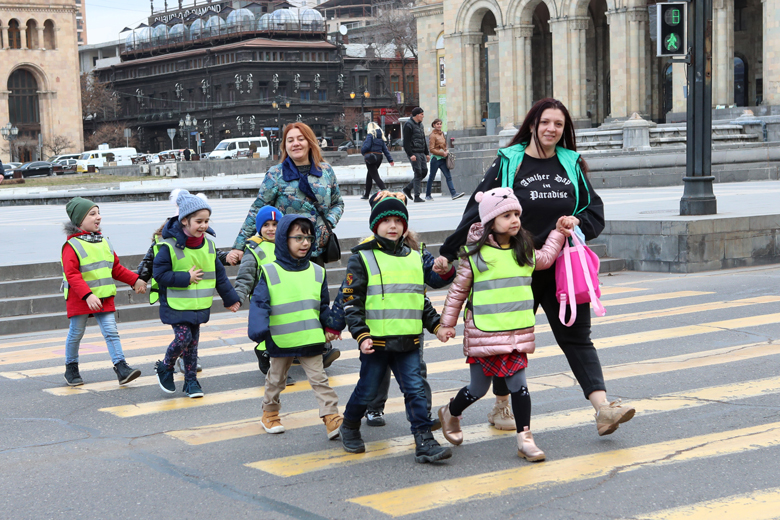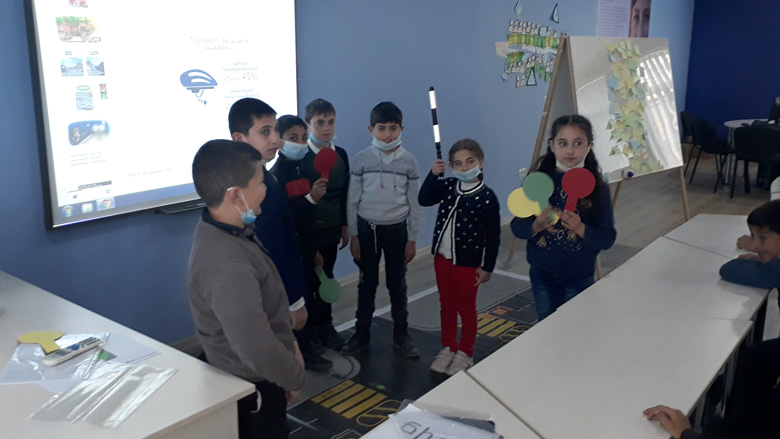As of today, 23 community schools have benefited from the road safety program, and roughly 900 pupils have received training in the central regions of Kotayk and Ararat. In total, children from 85 Armenian communities will be trained under the project. The engagement approach is to use age-appropriate interactive education tools; for example, high school students are taking interactive tests on their cell phones, while children at the elementary level gain knowledge through fun interactive games and colorful booklets.
“Children’s knowledge and experience about the principles of road safety are better strengthened through such practical and interactive exercises and materials,” said Anna Gorgyan, a teacher at Karenis Secondary School in the Kotayk region. Ms. Gorgyan mentions that even though the rehabilitation works have included the installation of new road signs, drivers and pedestrians in the village do not always pay attention to them. The trainings have helped change the way people think and behave by creating a culture of strict adherence to traffic rules from an early age.
Varazdat Avetisyan, a third grader at Karenis school, smiles: “I didn’t know that in the late hours, when it is dark outside, pedestrians should try to wear light-colored clothing so that they are visible to drivers while crossing the road. And that headphones should be removed when crossing the road so as not to get distracted.”
Road safety skills are best learned outdoors, in a real traffic environment. Children learn by experience, and adult interaction is an important part of that process. As children walk, they ask questions about roads, signs, traffic, and how and where to cross the road. An educated child brings the knowledge back home and may teach friends about road safety issues.
As part of this commitment to safety, the project team has also been working to implement enhanced people-centered design features along targeted roads and is collaborating with traffic police to enhance crash data systems in the country.
While Armenia works toward a resilient recovery from the recent war and ongoing pandemic, it is essential that it continue to embrace new opportunities. Addressing road fatalities and providing safer mobility for all citizens, particularly children, is one bold way to ensure a brighter future for the country.
As of today, 23 community schools have benefited from the road safety program, and roughly 900 pupils have received training in the central regions of Kotayk and Ararat. In total, children from 85 Armenian communities will be trained under the project. The engagement approach is to use age-appropriate interactive education tools; for example, high school students are taking interactive tests on their cell phones, while children at the elementary level gain knowledge through fun interactive games and colorful booklets.
“Children’s knowledge and experience about the principles of road safety are better strengthened through such practical and interactive exercises and materials,” said Anna Gorgyan, a teacher at Karenis Secondary School in the Kotayk region. Ms. Gorgyan mentions that even though the rehabilitation works have included the installation of new road signs, drivers and pedestrians in the village do not always pay attention to them. The trainings have helped change the way people think and behave by creating a culture of strict adherence to traffic rules from an early age.
Varazdat Avetisyan, a third grader at Karenis school, smiles: “I didn’t know that in the late hours, when it is dark outside, pedestrians should try to wear light-colored clothing so that they are visible to drivers while crossing the road. And that headphones should be removed when crossing the road so as not to get distracted.”
Road safety skills are best learned outdoors, in a real traffic environment. Children learn by experience, and adult interaction is an important part of that process. As children walk, they ask questions about roads, signs, traffic, and how and where to cross the road. An educated child brings the knowledge back home and may teach friends about road safety issues.
As part of this commitment to safety, the project team has also been working to implement enhanced people-centered design features along targeted roads and is collaborating with traffic police to enhance crash data systems in the country.
While Armenia works toward a resilient recovery from the recent war and ongoing pandemic, it is essential that it continue to embrace new opportunities. Addressing road fatalities and providing safer mobility for all citizens, particularly children, is one bold way to ensure a brighter future for the country.




